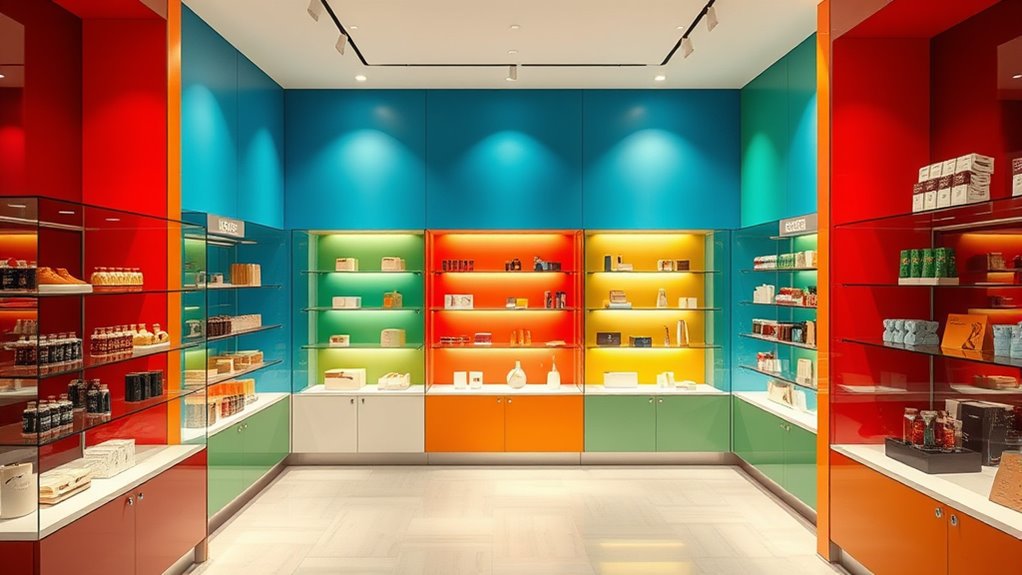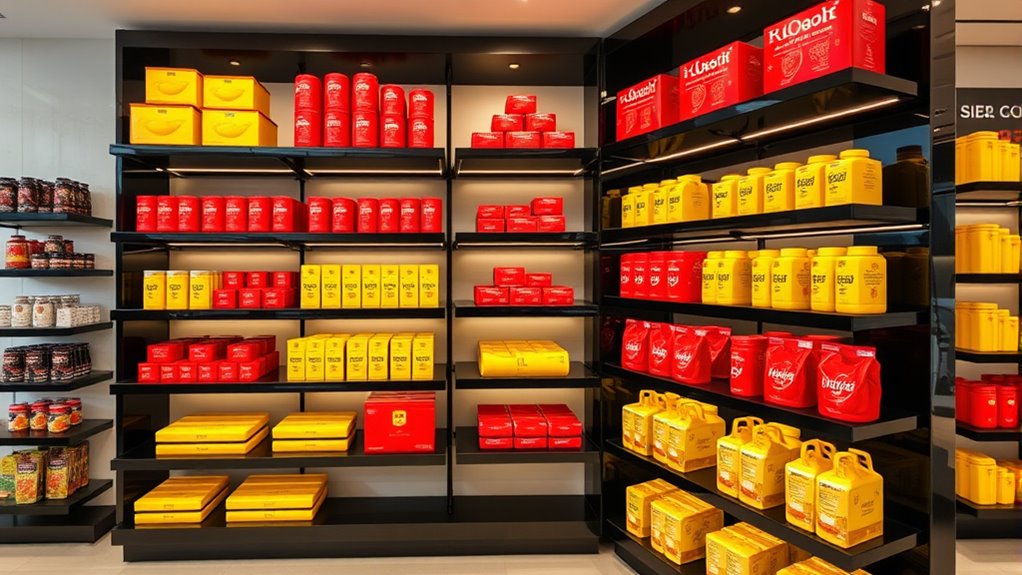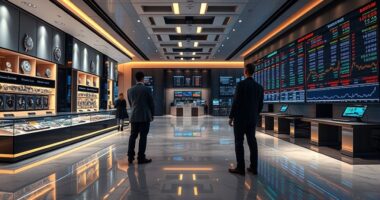To boost sales through visual merchandising, focus on strategic product placement at eye level and near high-traffic areas, using colors that evoke specific emotions. Warm tones like red and yellow create urgency, encouraging quick decisions, while cooler colors like blue and green foster trust and relaxation—ideal for longer browsing. Combining placement with cohesive color schemes guides customers naturally through your space, increasing engagement. Keep exploring to discover how optimizing these elements can make your displays more compelling.
Key Takeaways
- Strategic placement of high-margin products at eye level attracts attention and boosts sales.
- Using warm colors like red and yellow in displays creates urgency and encourages quick purchases.
- Grouping products by theme or color simplifies choices and enhances visual appeal.
- Bright, contrasting colors at key points draw customer focus and increase engagement.
- Combining color schemes with thoughtful placement guides shoppers through the store, increasing browsing time and spending.

Have you ever wondered why some store displays instantly catch your eye and draw you in? It’s not just luck or random arrangement — it’s strategic visual merchandising rooted in understanding human psychology. Two powerful tools in this domain are product placement and color psychology. When used effectively, they can influence your shopping behavior, encouraging you to linger longer and make more purchases.
Product placement is about positioning items in ways that maximize visibility and appeal. Imagine walking into a store and noticing certain products at eye level or right at the front. You’re naturally drawn to these spots because our brains are wired to notice what’s most accessible and prominent. Retailers carefully plan where they place their high-margin or promotional items to catch your attention quickly. This isn’t accidental; it’s a deliberate effort to guide your eye and, ultimately, your wallet. When you see products grouped by theme or color, it simplifies your decision-making process, making it easier to pick up what feels most appealing.
Color psychology plays a vital role in this process. Different colors evoke specific emotions and reactions, influencing how you feel about a product or a store. For example, warm colors like red and yellow can create a sense of urgency or excitement, prompting you to act fast or feel energized. Red, often associated with clearance sales or limited-time offers, pushes you to make quick decisions. On the other hand, cooler tones like blue and green tend to foster trust and relaxation, making you more comfortable browsing longer and feeling good about your choices. Retailers utilize these insights by choosing colors strategically for signage, backgrounds, and product packaging to evoke desired responses.
Additionally, understanding the power of imagination can help retailers craft displays that inspire desire and aspiration, subtly influencing your perception of the products. When product placement and color psychology work together, they create a cohesive shopping experience that feels natural and compelling. Brightly colored displays placed at strategic points draw attention to specific products, while the color scheme guides your emotions toward feeling confident or excited about your potential purchase. It’s a subtle dance of visual cues that nudges you toward spending more time in the store and ultimately spending more money.
Understanding these principles helps you become more aware of how stores influence your buying decisions. The next time you walk into a retail space, pay attention to how products are arranged and what colors dominate the environment. Recognizing these tactics allows you to shop more consciously rather than being unknowingly manipulated by visual merchandising strategies designed to increase sales.
Frequently Asked Questions
How Does Lighting Influence Customer Purchasing Behavior?
Lighting plays a pivotal role in shaping your retail ambiance and influencing your purchasing behavior. Well-placed lighting creates an inviting atmosphere, encouraging you to explore and spend more time in the store. It also enhances emotional engagement by highlighting key products and setting the right mood. When a store uses effective lighting, it makes you feel comfortable and more likely to make impulse purchases, boosting sales naturally.
What Role Does Signage Placement Play in Sales?
Signage placement acts like a guiding lighthouse, steering customers toward what’s important. When you strategically position signs near window displays or along shelves, you catch shoppers’ attention and direct their path effortlessly. Clear, well-placed signage enhances shelf organization, highlighting key products and encouraging purchases. By placing signs thoughtfully, you create a seamless shopping experience that boosts sales and keeps customers engaged, turning browsing into buying.
How Do Scent and Sound Affect Shopping Decisions?
You might not realize it, but scent and sound play a big role in your shopping decisions through sensory branding and emotional cues. A pleasant aroma can make you linger longer, boosting your likelihood to buy, while background music influences your mood and pace. Retailers use these sensory cues intentionally to create an inviting atmosphere, encouraging you to stay, explore, and ultimately make more purchases.
What Is the Impact of Store Layout on Customer Flow?
You notice that store layout greatly influences your movement through aisles. Effective aisle design guides you smoothly from one section to another, encouraging you to explore more. Well-organized shelves catch your eye and make shopping easier, reducing frustration. When stores optimize layout with clear pathways and strategic shelf organization, you’re more likely to stay longer and purchase more. Your shopping experience feels seamless, making store layout a key factor in increasing sales.
How Can Digital Displays Enhance Visual Merchandising?
Digital displays can considerably boost your visual merchandising by engaging customers with interactive technology. You can showcase dynamic content, product demos, or special offers that catch attention. Plus, integrating social media feeds encourages shoppers to connect online, increasing brand engagement. These tools create an immersive shopping experience, making your displays more memorable and driving sales. Embrace digital displays to modernize your merchandising and keep customers interested and involved.
Conclusion
By understanding how color placement influences customer behavior, you can strategically boost your sales. Remember, studies show that 85% of shoppers cite color as a primary reason for purchasing a product. So, when you carefully choose and position colors in your displays, you’re not just decorating—you’re guiding your customers’ decisions. Use this knowledge to create compelling, psychologically impactful displays that encourage buying and maximize your store’s potential.










